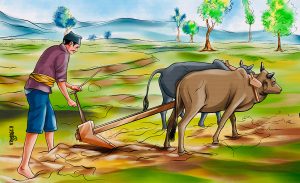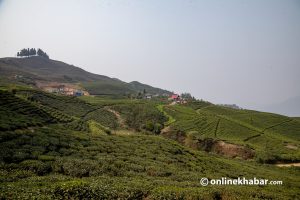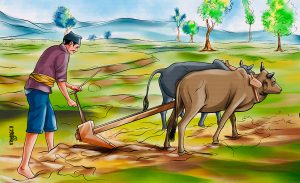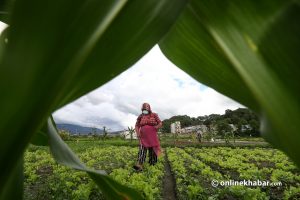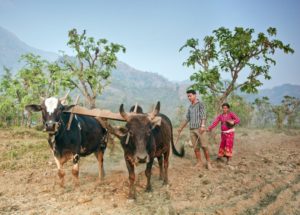“Ravi,” someone called. I looked back to find a familiar face smiling at me. That was Pawan and we had met after some six years. Pawan Kumar Ghimire, now a resident of Dhapashi of Tokha in Kathmandu, was into shiitake mushroom growing when we were neighbours then.
Curious, I asked him if he was still into it. He said he had added one more farm to his maiden venture at Jhor to another at Gurje Bhanjhyang (elevation: 1,800 m), 18/19 km from Kathmandu with acreage of seven ropanis of land.
That was enough to trigger off my curiosity. I asked him if I could visit his farm with him, and also put across my interest to do a story on it. Bingo! The answer was a big yes and the visit was scheduled for another week.
History
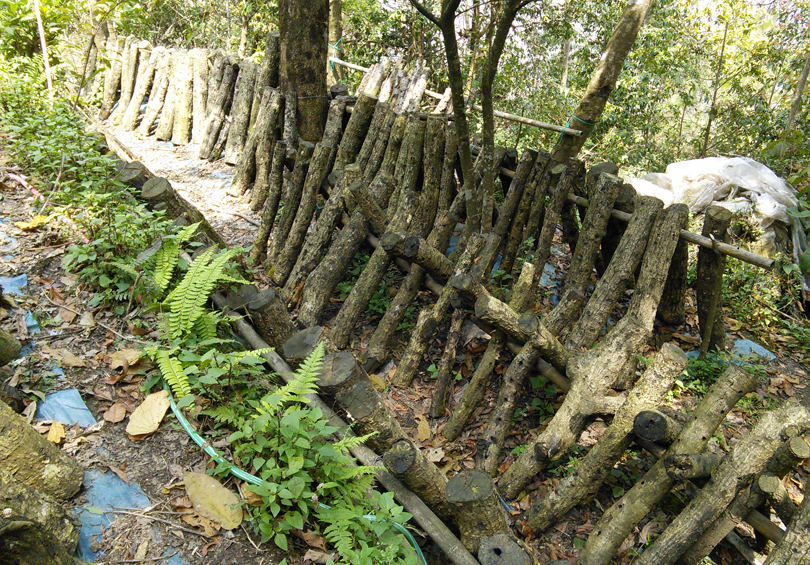
The history of shiitake (Lentinula edodes), in essence a decomposing fungus indigenous to wild forests, dates back to millions of years to the Cretaceous period, when the Dinosaurs roamed the earth. Endemic to only Asia, mostly the Far East, it’s called donko in Japan, and shanku and dongo in China. Today it’s grown almost all over the world and widely used in oriental cookery. It also falls under WHO’s recommendation as one of the most nutritious mushrooms in the world.
More than that wood-log cultivation of shiitake is 100 per cent organic as no pesticide or chemicals are used in this farming like other commercially grown edible mushrooms.
It is said the Chinese were the first to forage for it in the wild and use it for its nutritive value and therapeutic qualities. Chinese legends also claim that it has aphrodisiac properties. The name ‘shiitake’ is a derivative from the Japanese word: shii meaning a kind of oak and take translating to mushroom. In short, the edible shiitake mushrooms are grown on deciduous hardwood tree logs, mostly oak.
As planned, we left for Gurje Bhanjhyang, the windy gravelled road, all the way uphill from Jhor, was steep, near vertical at places, with lots of pits and muddy stretches. I was afraid that my car would get mired down. Thankfully, nothing untoward happened and we arrived at Gurje Bhanjhyang (Pass). The pass was manned by an army check post.
To reach the farm, we had to drive 1.5 km down the Nuwakot Highway, take a turn at a fork and catch the Melamchi Highway (underway). We pulled up after a furlong, parked the car at a roadside teahouse and walked some five to seven minutes to the farm tucked away on the northern face of the densely forested hill.
The farm appeared like a mix of a big orchard, a forest, and tangled vegetation. To me, the whole farm looked like a forest land. The steep densely wooded slope to the north of the farm dropped all the way down as far as you could see.
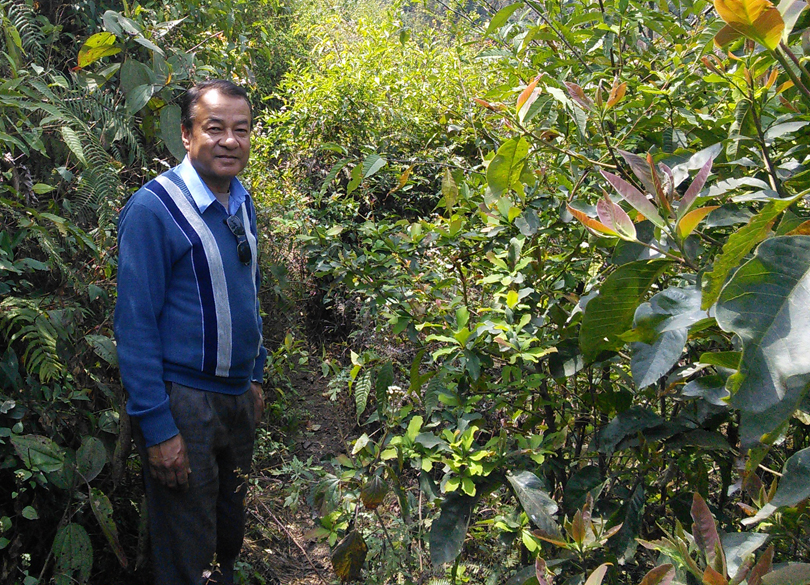
Presently, he is growing shiitake mushrooms on 4,000 logs. After a tour of the farm, we sat down for an interview. The hushed and relaxed ambiance of the place felt like being more amidst a jungle than a farm.
Q: How long have you been into shiitake farming and what did inspire you to do it?
A: I started doing shiitake farming eight years ago. After retirement from work (I worked for Save the Children USA for 26 years), I was looking for some kind of work. Right from my early years, I’d a keen interest in botany and husbandry. That prompted me to go into farming after retirement.
I wanted to start something new, less invaded by a competitive market. I’d my mind set on doing ganoderma or reishi mushroom farming, relatively a new concept in Nepal then.
I visited the Department of Agriculture, Khumaltar and met Dr Naoaki Watanabe, a Japanese expert on mushroom farming (JICA volunteer), who advised me do shiitake farming instead.
The reasons for that he explained were: a) Shiitake growing was less complicated and easier, b) required less acreage (you can do it indoors, outdoors, in natural forest and even in tunnels or poly-tunnel farming with ease of marketability).
More than that, shiitake is well known worldwide as a culinary delicacy and one of the most highly prized gourmet varieties. Also, shiitake fetches a much higher return compared to other mushrooms like button and oyster. Shiitake sells for Rs. 700.00 to 800.00 per kilo in Nepal.
Ganoderma farming, very similar to shiitake (shiitake grown on the bark of cut logs/ganoderma on sawed-off blocks) on the other hand, calls for greenhouse management requiring regulated climatic conditions and calls for more acreage. Regarded more as medicinal fungi, in Nepal’s context, it has negligible commercial viability. I had to listen to the expert, so I switched my mind to shiitake.
Consequent to our further meetings, the Japanese gentleman took me to a couple of shiitake farms run by him and helped me with the technical expertise.
Q: Before going into the details, please give a quick rundown on the basics of shiitake mushroom farming.
A: Shiitake, one of the many edible fungi cultivated commercially is grown on hardwood logs with thick barks. They survive, germinate and thrive on the substrate or the sapwood of the log.
You need freshly cut young logs from live green healthy trees. The logs cut from the trees felled in mid-winter to late winter are best–so to have them ready for inoculation in early spring.
Care should be taken to ensure that only logs with intact bark are selected. Logs with too many cracks and gaps should be discarded for the reason that, by nature, shiitake mushrooms are very sensitive to external contamination, both by contact and its close proximity to their environs. Gaps in the barks provide entrance points for other wild strains of fungi that lurk around.
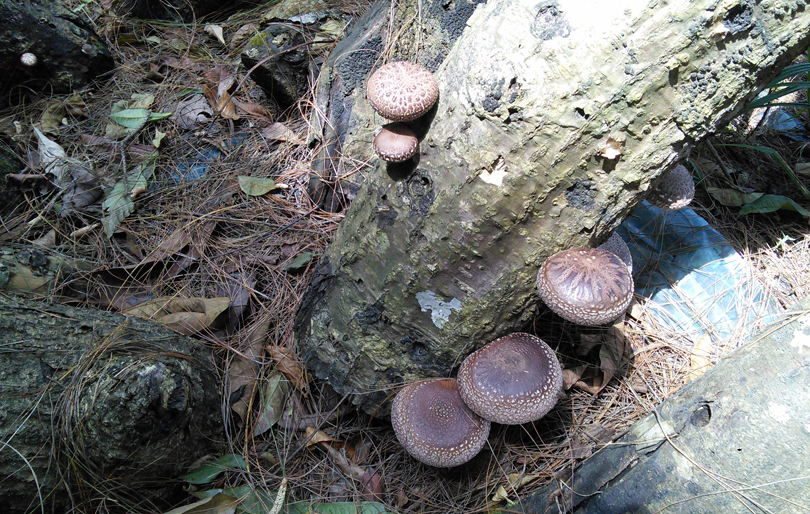
Q: What kind of tree logs is used at your farm and what wood is considered best for this farming?
A: Presently, we have katus (Castanopsis indica) and uttis (Alnus nepalensis) at our farm in Gurje and Jhor. Other preferred hardwoods are: walnut, saur, chilaune, lakur
Farming on uttis log is more economical than other hardwood as they come cheap. Their light weights also facilitate easier handling. They, however, need more care and maintenance and have a shorter life. When we started with uttis logs, we harvested the mushroom from them for only three years after inoculation.
Presently, we are growing shiitake only on katus logs. Katus wood is heavier with thicker bark and stronger than uttis. Katus logs bear fruit for five years.
In the Far-East countries, Europe and USA, preferred wood are white, red, pin-oak, sugar maple, ironwood, elms, sweet gum, beech, etc. In short, you need hardwood to farm shiitake.
Q: What’s the ideal elevation and climatic condition for shiitake farming?
A: Shiitake mushroom prospers well at an elevation above 1,200 m to 2,400 m. Kathmandu with its elevation at 1,400 m and its periphery hills with a cool temperate zone in between 2000 to 2400m are suitable for farming of this species. A cool humid climate is best suited for its growth.
When growing shiitake mushrooms in the open, the logs should not be exposed to direct sunlight. Shaded areas or trees serving as natural canopies best suit their farming. An access to a northerly wind is favourable for their healthy growth.
Q: What size of log is best for shiitake?
A: The ideal size of cut logs should be six to eight inch in diameter and three to four feet in length. The logs any longer than that are difficult to handle; shorter and thinner logs dry out fast.
Next, you hydrate the logs in a water bath and soak them for two weeks. Then, you allow the cut logs to sit or age for two/three weeks. After that, it’s time for the inoculation of the seeds known as spores or shiitake spawn.
Appearing like sawdust, it consists of mycelium culture grown into hardwood sawdust. The seeds or spores are available in Kathmandu at CATT, Centre of Agricultural Technology and Training, Imadol, Gwarko, Lalitpur.
The logs now need to be drilled with 5/16 diameter. Pores of an inch and a quarter deep for the spores have to be injected into the sapwood core between the heartwood and the bark. The holes or pores are spaced six inches apart along with the lower three inches apart, which are staggered creating a triangle or a diamond pattern. The logs measuring one metre long with a 7/8 inch diameter can hold some 80 to 90 pores.
It’s to be noted that the best temperature at the time of the inoculation is 25-26 degree Celsius (77 degrees Fahrenheit) to enable healthy and rapid growth of the mycelium. In higher temperature, the growth is stunted.
Likewise, the temperature should not go below 15 degree Celsius. The spores after inoculation turn into mycelium, which grows and colonises the entire log allowing the fungus a significant amount of meat to be chewing on and gradually triggers off the process of germination by feeding on the cellulose and lignin of the dead log.
In seven to nine months, the spores develop into fruiting bodies on the surface of the bark of the log and start popping up to full bloom. That’s how shiitake gets it final form.
After the proper holes are drilled into the logs, you have to drive in the spores or seed in as far in as they go and use a dowel to push them in leaving a little space. The next process is to heat the beeswax and then pour it into the empty space in the pores and fill them to the top and let the hot wax cool off and harden.
For ease of work, you can also use a brush to seal the pores with the liquefied wax. The pores need to be hermetically sealed to make them airtight to allow free germination of the spores and avoid risking the competition or contamination from other wild fungi.
It’s time now for the logs to be stacked in a partially shaded area (half-sun half shaded if you are doing the farm in open area under the shade of trees) or the laying yard in a roofed shed. The logs are crib stacked with open spaces between them to allow air to pass.
Q: How long does it take the final fruiting and harvesting of the shiitake mushrooms?
A: In Japan, China, and other far-east countries, the harvesting is achieved from six months onwards. In Nepal, it takes eight to nine months.
Q: What is the recommended time for the inoculation of shiitake spores into the cut and cured logs
A: The inoculation of shiitake spores starts in Mangsir or mid-November-December through Poush or mid- January. The next inoculation can be done in Magh/Phalgun (January-February-March) and finally in Chaitra/Baishakh (mid-March-April). No inoculation is recommended for the rest of the months.
Q: What kind of care has to be given to the logs after inoculation until the fruiting period (8/9 months)?
A: The pre-fruiting time of eight/nine months is a bit labour-intensive. The crib-stacked logs have to be water-sprayed in 3/4 days depending on the moisture in the air. The ideal moisture to be maintained should be above 60rh. In case of incessant rain, the stacks have to be covered with plastic sheets.
During fruiting time air moisture should be 80/90 rh. Besides taking care of air moisture, the logs need to be turned each month until fruiting time so that the moisture in the log and the mycelium spread is kept at balance.
With the arrival of fruiting time, the sprouting tiny shiitake mushroom knobs dispel a kind of wild aroma and shed a creamy type of fungi powder. After this period, the crib-stacked logs are stored in a lean-to pattern. After harvesting, the logs are again transferred to the crib-stack for the “sleep-time” or 8/9 months.
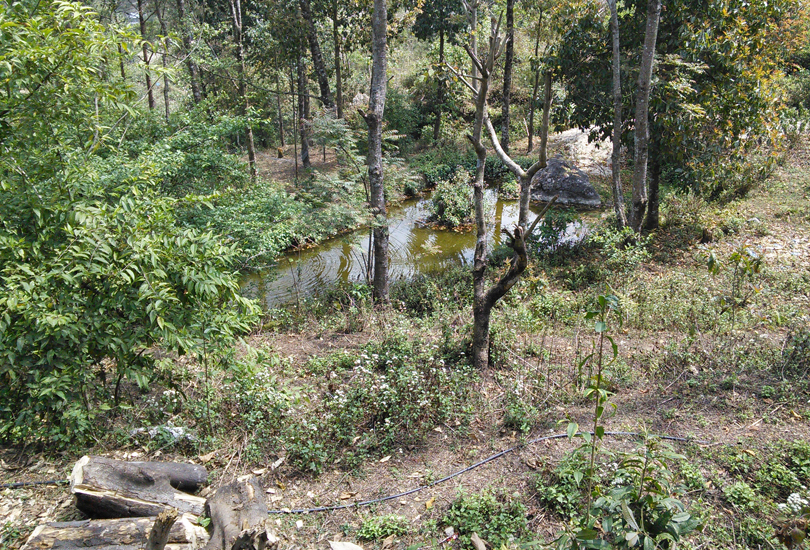
Q: How is exactly the harvesting of the mushroom done after eight/nine months?
A: After eight to nine months, the first shiitake tiny knobs start appearing on the logs. The tiny knobs start growing into full-size fruits in six-seven days and the harvesting kicks off. It’s quite a sight to see the fruits blanket the entire log.
Harvesting them is like milking a cow. The mushrooms are picked almost every day or every other day. The record yield from a log in my farm was 95 mushrooms from one log that had 90 holes. The large-scale farmers in Japan, China, Taiwan, and Korea have successfully harvested as high as eight to nine kilos from a single log in a season.
In Nepal, however, we still have to improve our skill and technique to achieve that goal. My farm has recorded a maximum of three kilos from a single log. Since our project is still in its infancy, we aim to improve in the coming years. The yield from a log depends on the mycelium growth. So, to obtain the best fruiting, they need proper care and supervision during their nine-month period of stacking. Once inoculated, the logs produce fruits every 8/9 months for 4 to 5 years.
During this “spawn run” of 8/9 months, care has to be taken to water them periodically for the logs to maintain their moisture. You have to avoid drying out of the logs at all costs.
Depending on the natural rainfall, basically, the logs need watering in an interval of 2 to 3 days to a week. In the event of frequent rains, they do not need watering.
—
The interview was done and I was enjoying the natural aura around the place when the caretaker lady at the farm served us with a plateful each of stir-fried shiitake (the leftovers from the harvesting). She had hand-picked them growing from the logs moments before. Fresh and juicy, they tasted just awesome . . . no words for it!
Suddenly, there was a deep rumble and I looked up to the skies. A black storm cloud seemed to stare back menacingly. Fearing what the rain could do to the already rough and slimy road, we decided to hasten back home.




